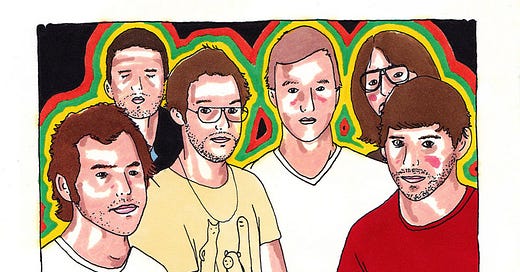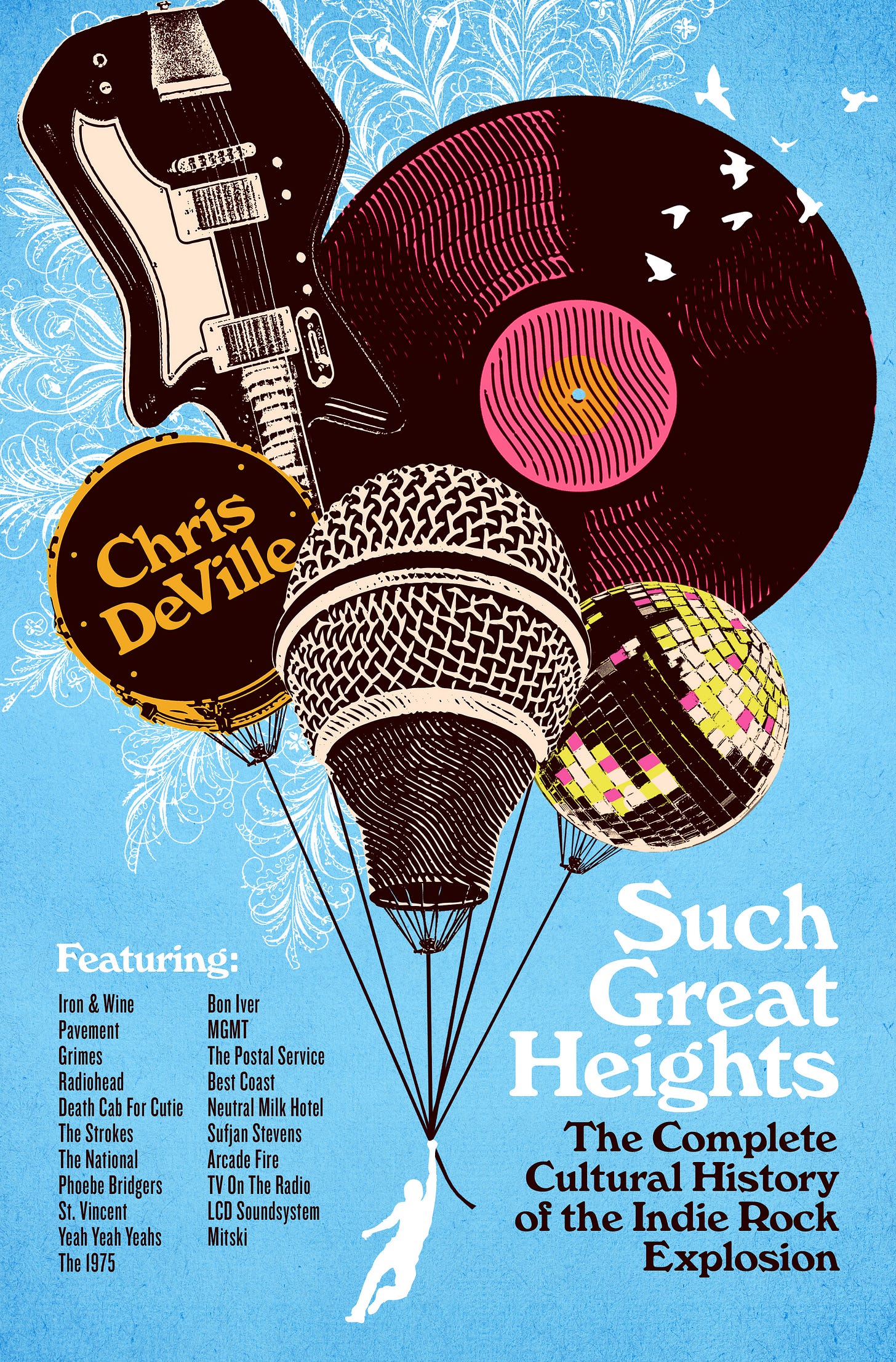A Tribute To Sessions
Today's SUCH GREAT HEIGHTS bonus material revisits Take Away Shows, Black Cab Sessions, Daytrotter, and the many online series that kept indie rock blogs populated with new performances daily
What do you remember about the glory days of music blogs? I remember MP3 download links, of course, which eventually became links to MySpace pages more often than not. I remember blogrolls, those lists of a blogger’s friends and favorites—curated portals to seemingly infinite worlds, aligned along the margin, reminding me how much was happening beyond my field of vision. I remember personalities being cultivated, points of view taking shape, treatises brilliant and inane published before a jury of commenters. I remember link roundups, keeping me endlessly entertained on my lunch breaks. And when the wheels of my memory start spinning, I remember sessions—so many sessions.
Sessions are a simple concept: recurring segments in which a special guest artist performs a song, maybe a handful of songs, usually from the new album they’re promoting but sometimes not. These kinds of promo ops have been part of music-nerd life since long before blogs came along. Back in the pre-digital era, bands’ miniature sets for radio fixtures like the BBC’s John Peel or KCRW’s Morning Becomes Eclectic were crucial documents to be circulated amongst an artist’s truest fans via official releases and bootlegs alike. More than a few rarities compilations and deluxe reissues were padded out with Peel Sessions.
But once the internet got to the point where most people could readily stream video, around the time YouTube went live in 2005, the same limitless publishing capacity that allowed writing and photography to proliferate also enabled countless kinds of sessions to get up and running. Ideas that previously might have been released on DVD—like the Burn To Shine series, in which bands from a given city would get together to perform one song each in a condemned house—could instead be published immediately to the web. And just as the tangled network of blogs and webzines became a feeder system for more established media outlets with a broader reach, the internet’s sprawling galaxy of sessions became a minor-league equivalent to the late-night TV appearances bands would do when they were really starting to pop.
I wrote about the hype-building power of MP3 blogs in my book SUCH GREAT HEIGHTS: The Complete Cultural History of the Indie Rock Explosion, which is available for pre-order now. One thing the book didn’t really get into was the wealth of audio and video sessions that became a fixture of the indie rock content mill, regularly filling digital column inches with fresh performances from buzzy new artists and established favorites. Remembering them now gives me the same twinge of wistful warmth I feel when I think about how Mad Men, 30 Rock, and Friday Night Lights were all on TV at that time.
You didn’t necessarily need video to create a great online indie music franchise. Starting in 2006, Sean Moeller made Daytrotter a treasured institution by simply recording performances in his no-frills studio in Rock Island, IL and posting MP3s with a colorful stylized illustration of the artist by Johnnie Cluney. Those little cartoons were enough to give Daytrotter a visual identity, and the bands—which amounted to a cross-section of the blog-world indie acts that were percolating at the time—provided a sonic persona for the series.
From my perch in Columbus, I was amazed at the number of talented and hyped-up bands that made their way through this remote Midwest outpost. How did Moeller get touring artists to stop by a tiny heartland river town, hours away from any major metro area, to play live with no overdubs in a dingy studio with no air conditioning? “I think I promised them pizza," Moeller once told NPR. "I think I was like, 'I'll buy you lunch,' and that was enough.”
Daytrotter occasionally posted videos of their sessions, and in its post-peak years—after Moeller turned it into a subscription service, moved it into a fancy new studio in Davenport, IA, and left the company in others’ hands—footage of the performances became a lot more common. But I don’t think of Daytrotter as a video series. Along with similar pursuits like the Lagniappe Sessions, launched by the esteemed blog Aquarium Drunkard in 2011, Daytrotter was something like a miniature podcast, a daily time capsule dropped into my RSS feed. (Aquarium Drunkard is still publishing Lagniappe Sessions, and they’re still great.)
Most of the most popular series involved not just visuals but some kind of visual gimmick. Starting in 2007, Jono Stevens’ Black Cab Sessions featured one-take performances in the back of a taxicab in London. It was a mostly lo-fi operation that attracted an impressive who’s who of indie music, including Fleet Foxes, My Morning Jacket, Grizzly Bear, and, of course, Death Cab for Cutie. (Naturally, they had Jens Lekman on to play “Black Cab” eventually.) Artists sometimes used these moments to do something outside their usual setlist, be it St. Vincent covering the Beatles’ “Dig A Pony” or the National trotting out Alligator B-side “You've Done It Again Virginia.” The extremely stripped-down setting also led to some fun flourishes like the Walkmen’s wonderful whistling, Chairlift’s fine finger-snapping, and Lykke Li’s tremendous hand-clapping. I would’ve loved to have seen what Joanna Newsom did with the format, but her harp did not fit inside a cab.
Whereas Black Cab Sessions confined musicians to a tight space, La Blogothèque’s Take Away Shows—the definitive blog-era video series, if you ask me—took them to locations around Paris, essentially turning burgeoning indie stars into high-class buskers. Series creator Christophe Abric has said he came up with the idea in 2006 after seeing Arcade Fire performing in the streets. Abric recruited his photographer friend Vincent Moon to capture artists like Beirut, Bon Iver, and Local Natives in gorgeous cinema verité. Bands sometimes made fun use of the unplugged and unmoored context, such as when Arcade Fire drummer Jeremy Gara ripped pages out of a phone book to keep the beat on “Neon Bible.” Eventually this project became transcontinental; Wilco’s first Take Away Show, for instance, was filmed backstage in Montreal by Derrick Belcham.
In 2014, by which point Moon had become a feature-length filmmaker, he told Line of Best Fit that the Take Away Show format was popular among artists at first because it was so refreshing. “Bands would come over on promo tours and spend the whole day in a dark room, answering the same questions every 30 minutes, and when we started doing the Take Away Shows, we were just saying, ‘Look, we’d like you to spend that 30 minutes in the street, playing for us.’ Back then, I think they found that very exciting. Nowadays, though, I have friends complaining to me, saying, ‘Wherever we are on tour, there’s always a fucking guy turning up with a camera asking us to play in the street!’ I think it’s been overdone now, and it’s starting to drive people nuts.”
It’s true that these kinds of sessions multiplied exponentially in the late 2000s and early 2010s, albeit not always in the streets. Pitchfork, then operating at the peak of its power and influence, seemingly invested some capital into Pitchfork.tv series like Don’t Look Down (bands performing on a rooftop), Juan’s Basement (bands performing in a basement), and Cemetery Gates (bands performing in a cemetery). On the more DIY side of things, If You Make It’s Pink Couch Sessions filmed artists from the punk and emo house-show scene performing on the same pink couch. Series creator Dave Garwacke compiled performances from the likes of P.S. Eliot, Bomb The Music Industry!, Hop Along, and Laura Stevenson, documenting a scene that was only embraced by hipster gatekeepers years later. It’s easy to see the Pink Couch as a precursor to NPR’s Tiny Desk, arguably the most popular and enduring of these video franchises today.
One other frequent angle for these videos was covers. So many video series have centered on artists performing another artist’s song, including still-ongoing franchises from the UK’s BBC Radio 1 (Live Lounge) and Australia’s triple j (Like A Version). The most fun iteration of this format was the A.V. Club’s A.V. Undercover, in which artists had to choose from a list of potential tunes that would dwindle as the season rolled along, until the last band invited was stuck performing the last available song. The original A.V. Undercover ran from 2010-2017, but after Paste Media acquired the A.V. Club last year, the company revived the series, yielding treasures like Cloud Nothings’ discordant noise cover of Iron & Wine’s “Naked As We Came.”
Really, though, you don’t need any conceptual scaffolding if you’re curating a great list of performers. A lot of video series got mileage out of simply inviting bands to their studio and letting them cook. Some, such as the AOL offshoot Spinner’s The Interface, have been lost to the sands of time. Some, including The Ship Sessions, arranged by Earlimart’s Aaron Espinoza, barely lasted a few episodes. Still others, like the staggering archive of performance clips from Seattle radio station KEXP, continue to expand to this day.
Maybe it’s just me, but even the coolest circa-2025 sessions don’t hit like they used to in the 2000s. It could be that the overabundance of content has caused me to take these kinds of clips for granted, or that working for a major music blog has demystified the process for me. Perhaps I’m just older and more jaded. These days, for innumerable reasons, it’s hard to feel the sense of possibility and magic that accompanied so much of this footage. But damn if they didn’t enhance my experience of indie rock back then, at a time when blogger-friendly bands were blowing up in culture-shifting ways.
SUCH GREAT HEIGHTS: The Complete Cultural History of the Indie Rock Explosion is out Aug. 26 via St. Martin’s Press. Pre-order it here.






Brilliant article. I really miss those days. Is your book getting a UK release? I'm looking forward to picking it up.
As someone who was a very minor player in those blog rock days, this really takes me back. You got exposed to so many different bands. I still remember hearing "Lucky You" for the first time when The National did Daytrotter.